
How to Configure and Edit Magento 2 Cookies?
[Updated On May 22, 2025] Looking for ways to optimize cookie consent without hurting user experience? Magento 2 cookies deliver a smooth and personalized shopping experience.
The tutorial explores configuring, editing, and updating Magento 2 cookies.
Key Takeaways
-
Session cookies and persistent cookies in Magento 2 are different.
-
Follow the steps to configure cookie settings in your Magento 2 admin panel.
-
Follow the steps to update your store’s cookie and privacy policy pages.
-
Advanced strategies include GeoIP consent and performance optimization.
-
Best practices help balance compliance with a smooth user experience.
What are Magento 2 Cookies?
Magento 2 cookies are small data files stored in a user’s browser. It helps manage sessions and enhance functionality.
These cookies handle tasks like maintaining session IDs and storing security tokens. It also preserves language or store preferences. They also deliver a secure and user-focused eCommerce experience.
Some cookies optimize site performance through caching. Others support personalization by remembering user-specific actions. These include cart contents or recently viewed items.
Magento 2 also allows integration with analytics and marketing tools. These may introduce third-party cookies for tracking and advertising.
Magento offers a cookie restriction mode to follow privacy laws like GDPR. It displays a consent pop-up before setting non-essential cookies.
2 Types of Cookies Used in Magento 2
1. Session cookies
-
Session cookies are temporary files. Magento 2 uses them to manage short-term data during a user’s visit to the site.
-
These cookies help track user activities like login status and form submissions. They also maintain the contents of the shopping cart while browsing different pages. They help ensure a smooth and consistent shopping experience.
-
Once the user closes their browser, these cookies get deleted. It makes them non-persistent and ideal for real-time session management and security.
2. Persistent cookies
-
Persistent cookies remain on the user’s device after the browser session ends.
-
Magento 2 uses them to remember user preferences and behaviors across various visits. These include storing information like selected store views and wishlist items.
-
These cookies enhance personalization by greeting returning users with their preferred settings. They don’t need to reconfigure it each time.
-
Persistent cookies have defined expiry dates. These can vary depending on the site's configuration.
Stores using configured persistent cookies see a 25% higher return visitor conversion rate.
7 Steps to Configure Cookies in Magento 2
1. Log in to your Magento 2 Admin Panel.
2. Go to Stores > Settings > Configuration.
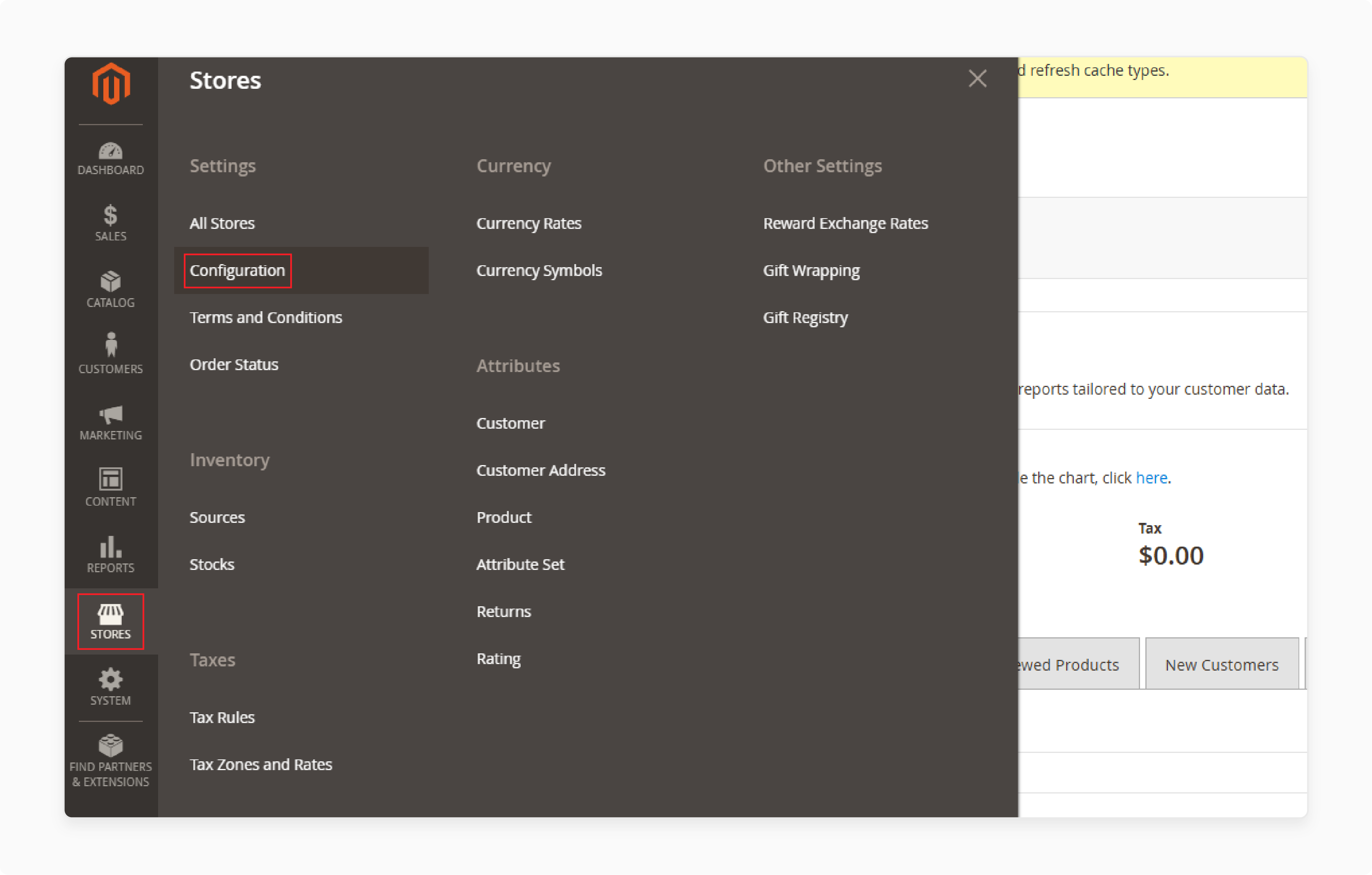
3. Under General, expand the Web section.
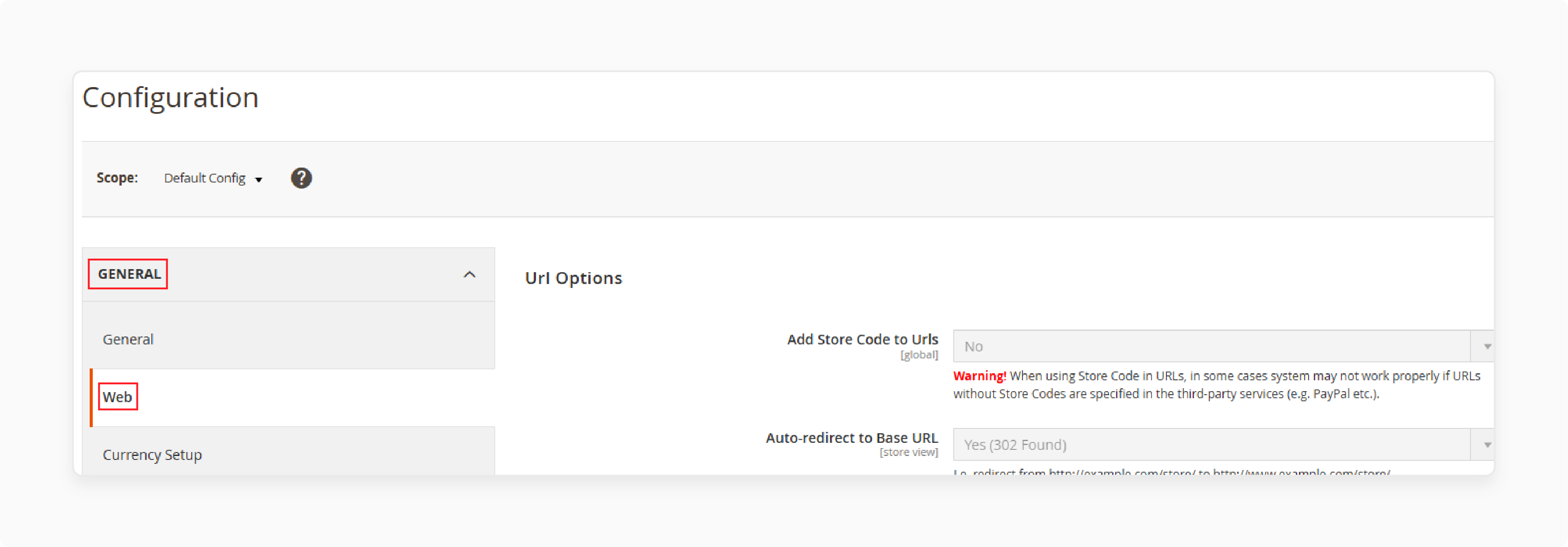
4. Open the Default Cookie Settings subsection. Configure:
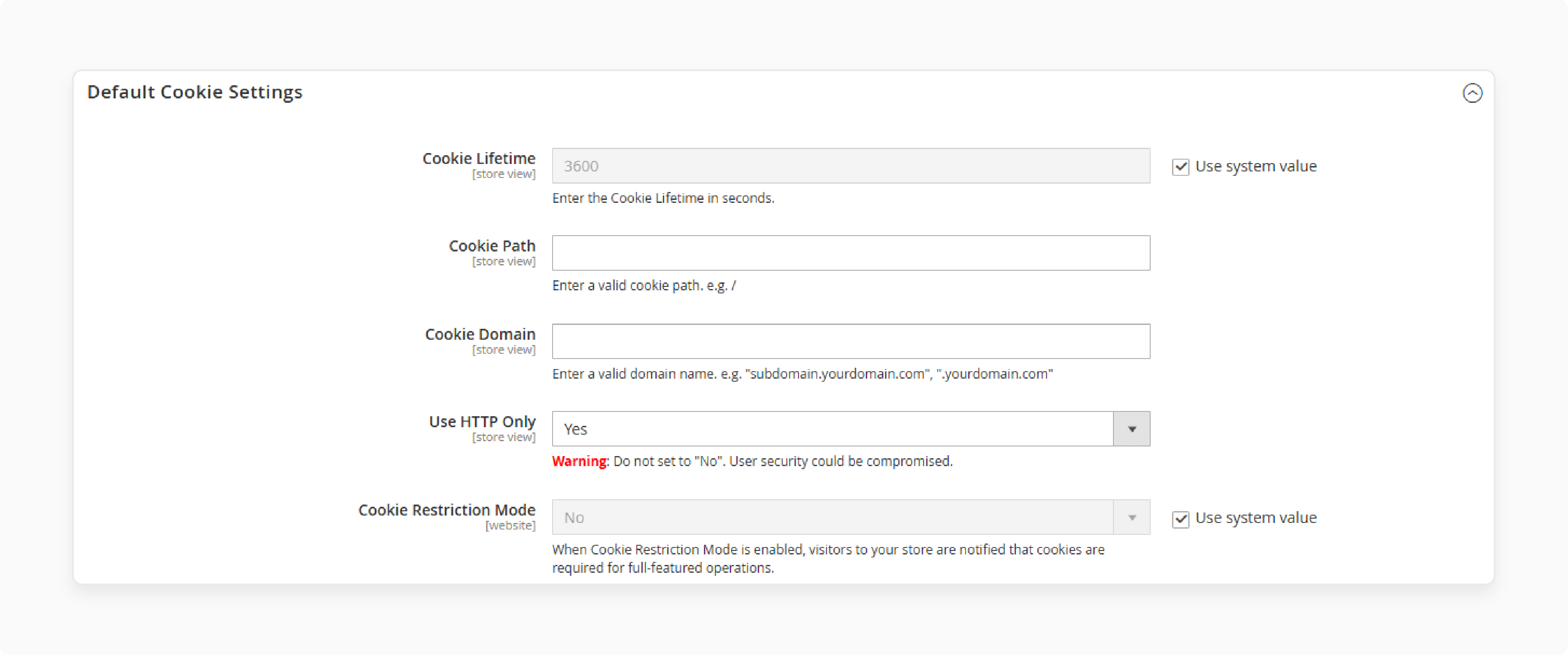
-
Set the cookie lifetime (in seconds) for how long cookies should remain active.
-
Default: 3600 (1 hour)
-
Set to 0 to expire cookies when the browser closes.
-
-
Use a forward slash / as the cookie path to make cookies accessible site-wide.
-
Input the cookie domain to allow cookie access across subdomains.
-
Set use HTTP only to YES to prevent JavaScript from accessing the cookies. It improves security.
-
Set cookie restriction mode to YES to show a cookie consent banner for compliance.
5. Click Save Config.
6. Go to System > Tools > Cache Management.
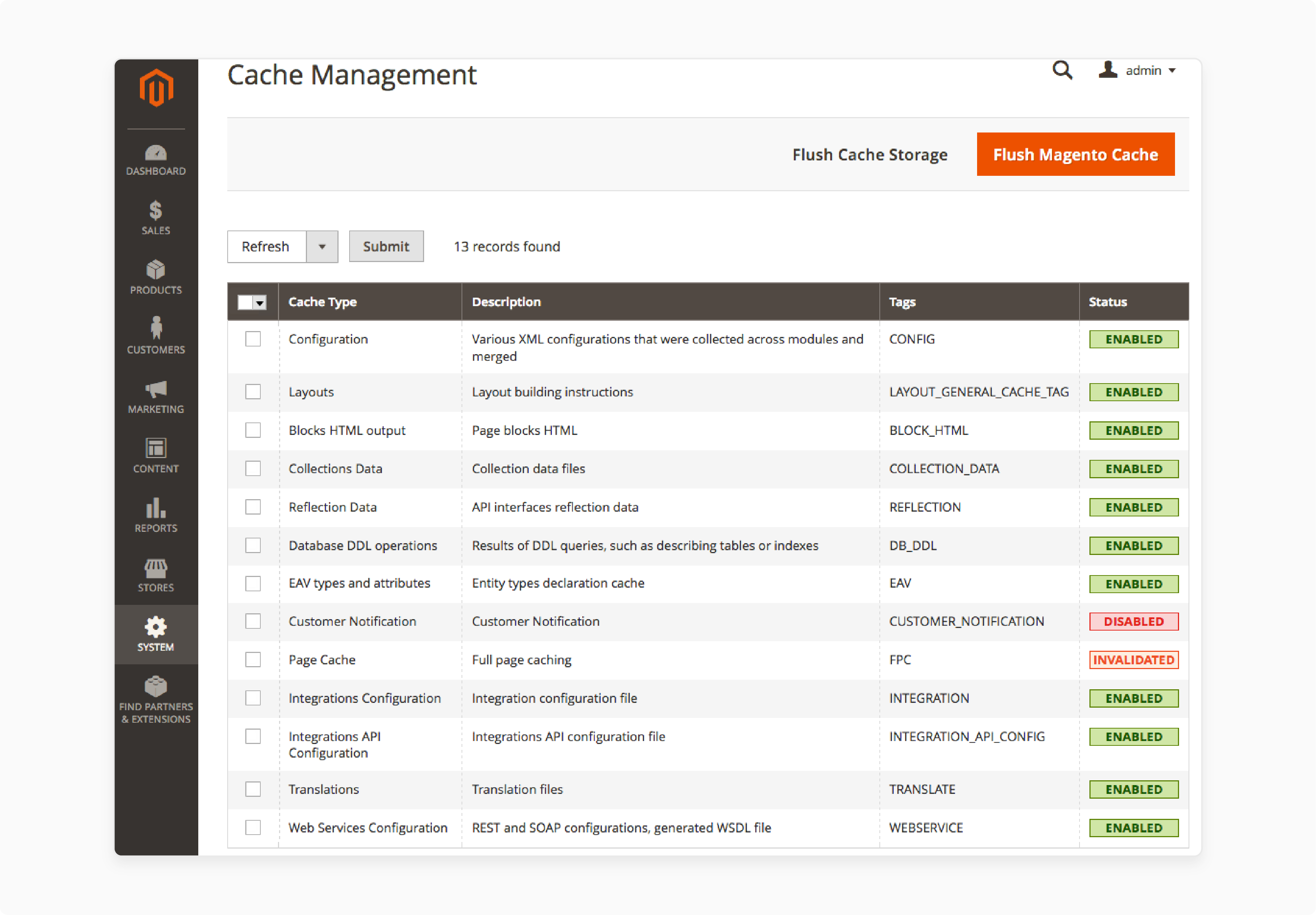
7. Click Flush Magento Cache.
8 Steps to Edit the Cookie/Privacy Policy Page in Magento 2
1. Go to Content > Elements > Pages.
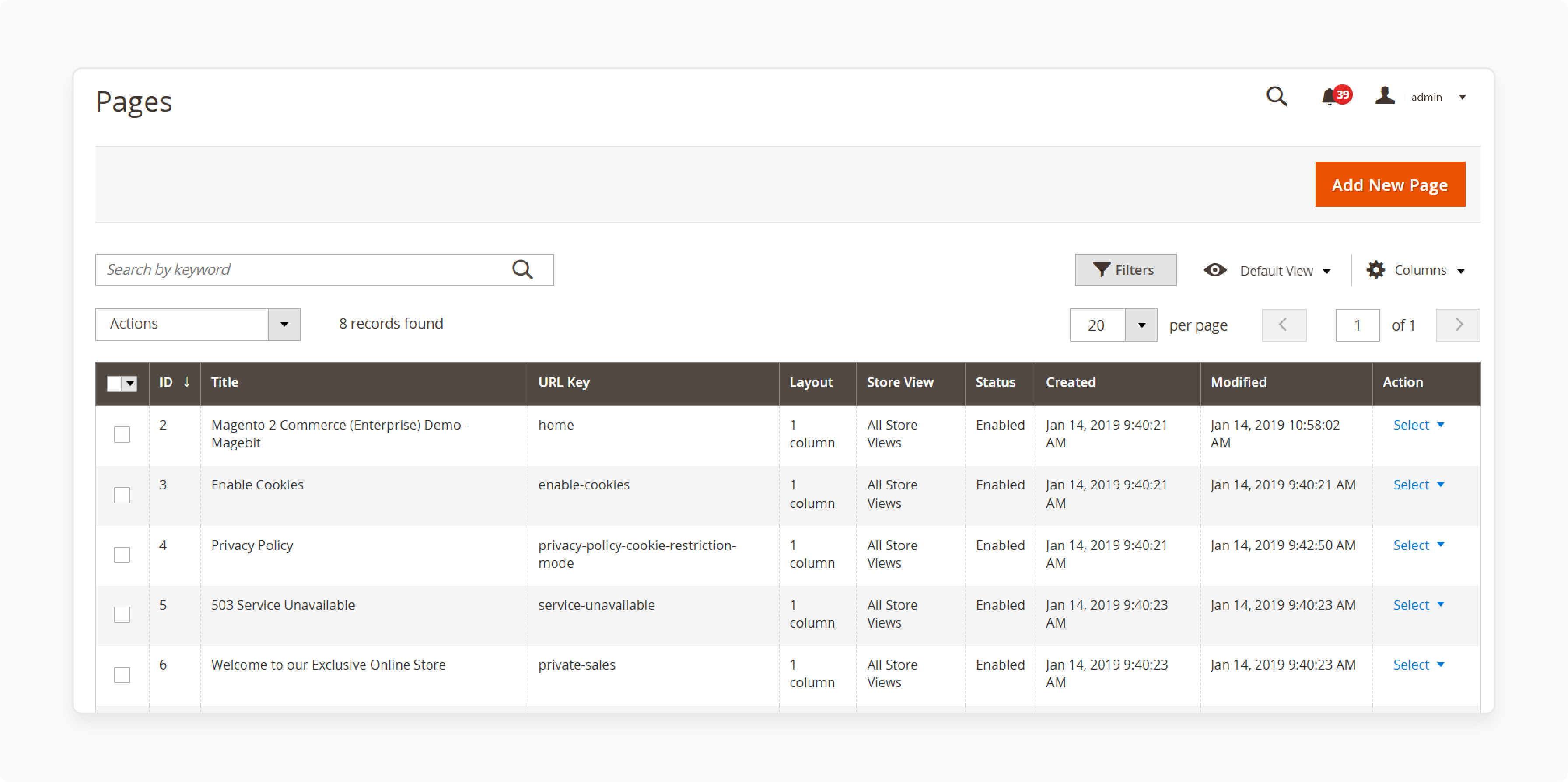
2. Locate the Privacy Policy page.

3. Click Edit from the Action dropdown.

4. Choose the relevant Store View and ensure Status = Enabled.
5. Under the Content tab, update the privacy or cookie policy text.
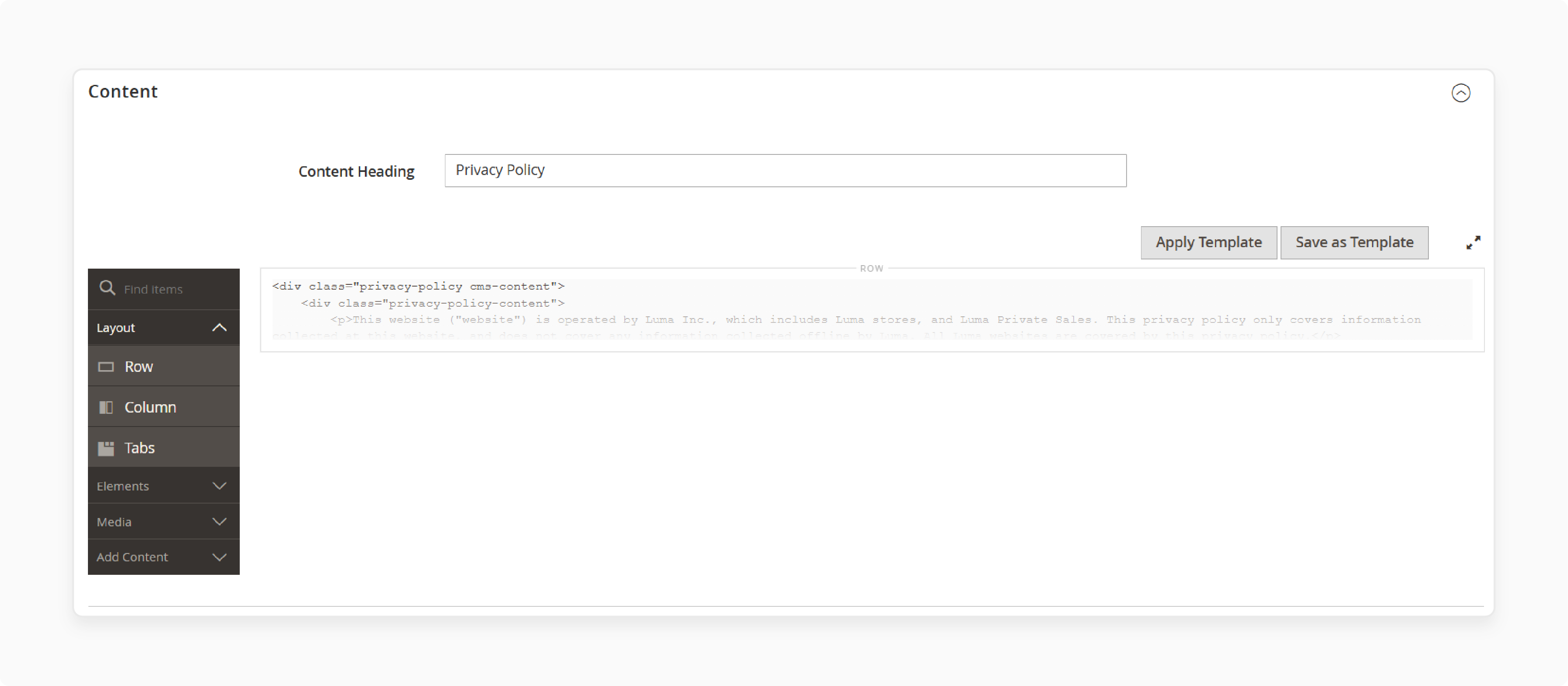
6. On the Page in Websites, assign the appropriate store view.

7. Click Save to apply changes.
8. Review the storefront to verify proper display of your updated policy.
8 Steps to Update the Cookie Consent Message
1. Navigate to Content > Elements > Pages in the Admin Panel.
2. Find the page titled Enable Cookies.

3. Select Edit from the Action column.
4. Enable the page and select applicable Store Views.
5. In the Content tab, update your cookie consent message.
6. Under Page in Websites, choose where it should display.
7. Click Save.
8. Verify the cookie message appears on your storefront.
5 Advanced Cookie Management Strategies
1. GeoIP-Based Consent Management
-
The strategy uses the visitor’s IP address to determine their location. It helps display the appropriate cookie consent banner.
-
For example, users from the European Union are subject to the GDPR. It requires explicit opt-in consent for non-essential cookies. Users from other regions may only need basic notifications.
-
Magento 2 can integrate with GeoIP services or third-party modules. These help automate the process. It ensures region-specific compliance and improves user trust.
2. Custom Cookie Grouping and User Preference Settings
-
You can categorize the cookies into groups such as essential and marketing. It helps enhance transparency and control.
-
You can extend Magento 2 with modules. It allows users to manage these preferences through a customizable consent panel.
-
The approach empowers users to accept or reject specific cookie types. It depends on their privacy comfort levels.
-
It also aligns your store with privacy regulations that need granular consent mechanisms.
3. Performance Optimization of Cookie Consent Solutions
-
Cookie consent tools should have minimal impact on site speed and user experience.
-
Poor optimization of scripts can delay page rendering. It also interferes with Magento’s core JavaScript. Use lightweight cookie management libraries and load consent scripts to avoid this.
-
Cache consent decisions and cut DOM manipulation. It ensures your cookie banners don’t slow down page loads, especially on mobile devices.
4. Multi-Language Support for Cookie Consent Banners
-
Use Magento 2’s multi-store and multi-language capabilities. It helps deliver cookie notices in the user’s local language.
-
It ensures that all users have a clear understanding of legal messages. It is whether by detecting browser language settings or using store view settings.
-
Many Magento's third-party GDPR extensions include built-in language packs or allow custom translations. It supports a global eCommerce strategy with consistent compliance.
5. Accessibility Considerations for Cookie Notices
-
Cookie consent banners should be accessible to all users. It includes those using screen readers or keyboard navigation.
-
It means adhering to WCAG, Web Content Accessibility Guidelines. It is by ensuring proper contrast ratios. It also makes all interactive elements operable by keyboard.
-
Magento merchants can also test their banners using accessibility tools. These include Lighthouse or WAVE, which help identify and fix issues.
-
The approach supports inclusivity and also reduces legal risk related to accessibility compliance.
5 Best Practices for Magento 2 Cookie Management
1. Balancing User Experience with Compliance Requirements
-
While you need legal compliance, it should not come at the cost of a poor shopping experience.
-
Use non-intrusive cookie banners that provide clear choices without obstructing key site functionality.
-
Ensure essential cookies load by default. It gives users full control over optional ones.
-
A well-designed, user-focused interface for cookie preferences builds trust and reduces abandonment.
2. Regular Auditing of Cookies Used on Your Store
-
Review all cookies set by your Magento 2 site. It includes those added by third-party extensions and analytics tools.
-
Use tools like browser developer consoles or compliance platforms like OneTrust or Cookiebot. They help identify unknown cookies.
-
Auditing ensures that your cookie policy remains accurate. It also helps detect any privacy risks or non-compliant behavior.
3. Keeping Your Cookie Policy Up-to-Date
-
As your Magento store evolves, through extension updates or legal changes. Your cookie policy must reflect those changes.
-
Describe what each cookie does and its duration.
-
Update your policy to maintain transparency. It also helps maintain compliance with international data protection regulations.
4. Performance Considerations When Implementing Cookie Solutions
-
Poor implementation of cookie banners can affect site speed and user flow.
-
Use lightweight scripts and load asynchronous cookie-related elements. It helps prevent blocking core Magento resources.
-
Ensure that consent tools don’t interfere with JavaScript-based features. These include AJAX carts and checkout processes.
5. Future-Proofing Your Cookie Strategy
-
Browsers are phasing out third-party cookies and increasing privacy controls. You should stay ahead.
-
Focus on first-party data collection and consent-based marketing strategies.
-
Magento store owners should track regulatory developments and browser updates. It helps you adapt.
-
Consider investing in privacy-first solutions and modular consent systems. These are easy to update as the landscape evolves.
FAQs
1. How can I test if my cookie consent is working?
Use browser developer tools to track cookies being set. Browse in incognito/private mode to simulate a first-time visit. Check to block the cookies before giving consent. Verify to record the consent.
2. Do I need a cookie consent banner if I only operate in the US?
While the EU's GDPR has stricter requirements. Many US regions, including California, have privacy laws that regulate cookie usage. You should use cookie consent regardless of your primary market.
3. How often should I update my cookie policy?
Review and update your cookie policy quarterly. Whenever you make significant changes to your website, it affects cookie usage. These include adding new third-party integrations or marketing features.
4. Can I use the same cookie settings for all my store views?
Magento 2 allows you to configure cookie settings at the global level that apply to all store views. For multi-regional stores, consider implementing different cookie settings per store view. It complies with different regional requirements.
5. How can I reduce the number of cookies my Magento 2 store uses?
Audit all third-party integrations and remove unnecessary ones. Configure analytics tools to use fewer cookies. Consider server-side tracking instead of client-side cookies. Use local storage for non-essential user preferences when appropriate.
Summary
Magento 2 cookies store small data in users’ browsers to manage sessions. The tutorial explores the key features of the tool, including:
-
Session cookies handle data during visits, ensuring smooth navigation and security.
-
Persistent cookies remember user preferences across visits, improving personalization.
-
Magento 2 offers a cookie restriction mode to follow privacy regulations.
-
Advanced strategies help balance legal requirements with user experience.
Enhance privacy compliance and performance with expert cookie management. Choose managed Magento hosting for a smooth setup and optimization.
[Updated On May 22, 2025]


